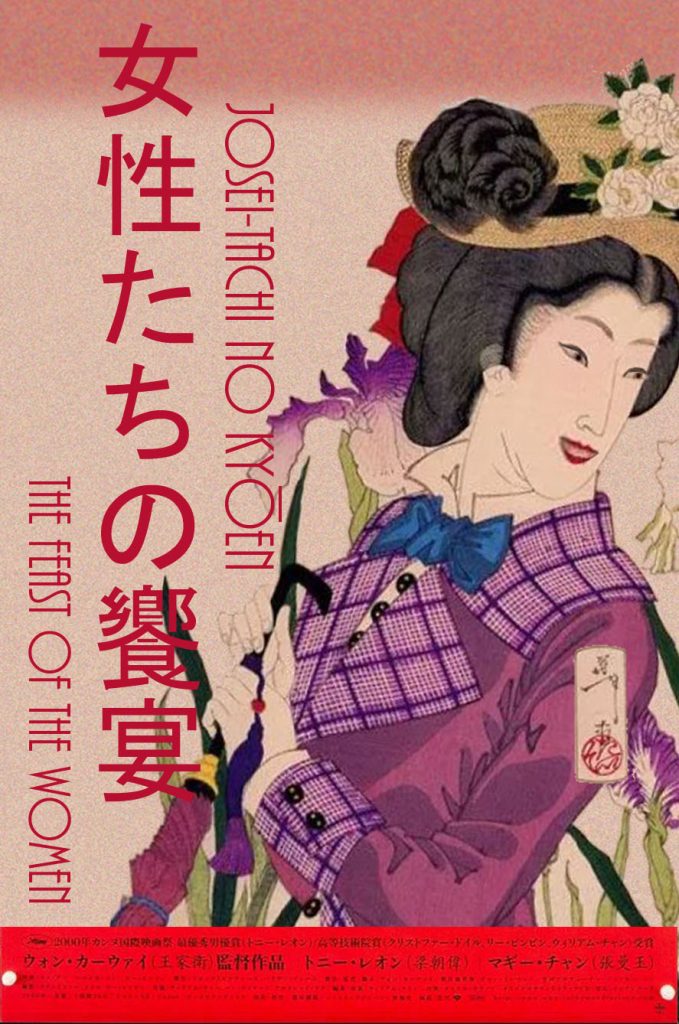by David Wiener (June 2024)

Review: The Feast of the Women, 2024, a Misaki Prestige Films and Sōzō-jō co-production
Based on the Novella An Undigestible Meal
Set at a time of sweeping change in Japan, this is the Babette’s Feast of the Meiji Era—but with a harder edge.
Visually, it is overwhelming—a panorama of color, composition, sets, and costumes that draw us into the public and private worlds of the upper crust in 19th century Japan. This was an entirely new type of high society (decreed by Emperor Mutsuhito himself), one that delighted in the very latest Western fashions—dresses, suits, hats, gloves, jewelry, and shoes that told everyone, “We are the new elite.”
No effort has been spared to recreate the lives of the filthy rich in Meiji Japan. Director of Photography Genzaide Wanai creates a palette of hues based on deep purples and reds, status colors which had for generations belonged to the people on top. But in the 1800s, these luxurious colors could be chemically synthesized and the nouveau rich embraced them as their own—not only did they denote wealth and status, they were the “team colors” of the people riding the crest of Meiji’s dizzying financial tsunami. It was an intoxicating, exciting, thrilling—and frightening time.
The first moments transport us to Tokyo’s Tsukiji hotel restaurant as Chef Louis Begeux (The Father of French Cuisine in Japan) escorts two impeccably-dressed elderly gentlemen to the finest table in the establishment. They are greeted by a western-style round of applause as a young dandy whispers to his girlfriend (a modern young woman wearing her hair in a sokuhatsu chignon), “What do the Parisians know of ‘La chasse à l’amour?’ Oh, the French may have invented it—but those two industrialized it!”
Itagaki Higenjitsuteki and Sanjo Sonzaishinai are two old friends who have spent their lives (and a hefty piece of their personal fortunes) bedding the greatest beauties in the “Land of the Gods.” Now quite elderly, the two old goats—still dressing and carrying on like Parisian roués—have practically become “Imperial Household Artists” (the Meiji forerunner of Living National Treasures) of Japanese Don Juanism.
Every year, on “Tennō tanjōbi,” the holiday of the Emperor’s birthday, they meet at Tokyo’s finest restaurant to reminisce.
A silent young waitress serves them as they recall the intoxicating beauties they have known. The waitress, who is supposed to remain invisible, suddenly violates all proper dining etiquette by speaking bluntly and directly to the two old men. It seems she has recognized one of the women they remember so fondly—a famous beauty from Osaka with whom they were both intimate.
After some discussion, they discover that the waitress is, in fact, the granddaughter of the famous Osaka beauty—and is very likely to be the granddaughter of Itagaki or Sanjo—but which one?
As something of a lark, they decide to take the girl on a trip to try and find her grandmother and figure out which old goat is her real grandfather. (“And why shouldn’t we?” Sanjo says to Itagaki with a Gallic shrug, “it’s a farce worthy of Feydeau himself!”) The waitress, Ichiyo, sees it as anything but a farce but is grateful to have a chance to find out where—and who—she came from. And with that, The Feast of the Women and turns into a unique kind of road picture, touching and underplayed to perfection.
The acting is wonderful, with Himari Tada no shinkirō playing the frightened waitress with heartbreaking skill; it’s a real shame that the great Kabuki actor Nakamura Ganjirō II died 44 years too soon to play either one of the old roués—but Haruto Otogibanashi and Yuto Sonzaishinai as Itagaki and Sanjo are both excellent.
Table of Contents
David Wiener has written cover, feature, and interview articles for various performing arts magazines including American Cinematographer, Producers Guild Journal, Cahiers du Cinema, and The Journal of the Royal Photographic Society of Great Britain. His plays have been produced in London, India, Canada, Australia, Mexico, and the U.S. and have been published three times in the Smith & Kraus “Best Plays” one-act anthology series. He In 2007, he completed a Literary Internship with La Jolla Playhouse and went on to work as that theatre’s Dramaturgy Associate during the 07-08 season.
Follow NER on Twitter @NERIconoclast
- Like
- Digg
- Tumblr
- VKontakte
- Buffer
- Love This
- Odnoklassniki
- Meneame
- Blogger
- Amazon
- Yahoo Mail
- Gmail
- AOL
- Newsvine
- HackerNews
- Evernote
- MySpace
- Mail.ru
- Viadeo
- Line
- Comments
- SMS
- Viber
- Telegram
- Subscribe
- Facebook Messenger
- Kakao
- LiveJournal
- Yammer
- Edgar
- Fintel
- Mix
- Instapaper
- Copy Link






